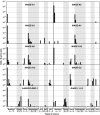Selective cancer-germline gene expression in pediatric brain tumors
- PMID: 18398575
- PMCID: PMC2440921
- DOI: 10.1007/s11060-008-9577-6
Selective cancer-germline gene expression in pediatric brain tumors
Abstract
Cancer-germline genes (CGGs) code for immunogenic antigens that are present in various human tumors and can be targeted by immunotherapy. Their expression has been studied in a wide range of human tumors in adults. We measured the expression of 12 CGGs in pediatric brain tumors, to identify targets for therapeutic cancer vaccines. Real Time PCR was used to quantify the expression of genes MAGE-A1, MAGE-A2, MAGE-A3, MAGE-A4, MAGE-A6, MAGE-A10, MAGE-A12, MAGE-C2, NY-ESO-1 and GAGE-1,2,8 in 50 pediatric brain tumors of different histological subtypes. Protein expression was examined with immunohistochemistry. Fifty-five percent of the medulloblastomas (n = 11), 86% of the ependymomas (n = 7), 40% of the choroid plexus tumors (n = 5) and 67% of astrocytic tumors (n = 27) expressed one or more CGGs. Immunohistochemical analysis confirmed qPCR results. With exception of a minority of tumors, the overall level of CGG expression in pediatric brain tumors was low. We observed a high expression of at least one CGG in 32% of the samples. CGG-encoded antigens are therefore suitable targets in a very selected group of pediatric patients with a brain tumor. Interestingly, glioblastomas from adult patients expressed CGGs more often and at significantly higher levels compared to pediatric glioblastomas. This observation is in line with the notion that pediatric and adult glioblastomas develop along different genetic pathways.
Figures



Similar articles
-
Cancer-germline gene expression in pediatric solid tumors using quantitative real-time PCR.Int J Cancer. 2007 Jan 1;120(1):67-74. doi: 10.1002/ijc.22118. Int J Cancer. 2007. PMID: 17019710
-
Cancer/testis antigen expression and specific cytotoxic T lymphocyte responses in non small cell lung cancer.Int J Cancer. 2007 Jan 15;120(2):337-43. doi: 10.1002/ijc.22309. Int J Cancer. 2007. PMID: 17066423
-
Pattern and clinical significance of cancer-testis gene expression in head and neck squamous cell carcinoma.Int J Cancer. 2011 Jun 1;128(11):2625-34. doi: 10.1002/ijc.25607. Epub 2010 Oct 8. Int J Cancer. 2011. PMID: 20715104
-
Expression of cancer/testis antigens in cutaneous melanoma: a systematic review.Melanoma Res. 2019 Aug;29(4):349-357. doi: 10.1097/CMR.0000000000000569. Melanoma Res. 2019. PMID: 30615012
-
[Expression of cancer testis (CT) antigens in pediatric and adolescent melanomas].Pathologe. 2017 Jul;38(4):303-311. doi: 10.1007/s00292-017-0311-z. Pathologe. 2017. PMID: 28631119 Review. German.
Cited by
-
The expression and clinical significance of melanoma-associated antigen-A1, -A3 and -A11 in glioma.Oncol Lett. 2013 Jul;6(1):55-62. doi: 10.3892/ol.2013.1351. Epub 2013 May 15. Oncol Lett. 2013. PMID: 23946777 Free PMC article.
-
Targets for active immunotherapy against pediatric solid tumors.Cancer Immunol Immunother. 2009 Jun;58(6):831-41. doi: 10.1007/s00262-008-0619-x. Epub 2008 Nov 14. Cancer Immunol Immunother. 2009. PMID: 19009292 Free PMC article. Review.
-
Aberrant expression of the hematopoietic-restricted minor histocompatibility antigen LRH-1 on solid tumors results in efficient cytotoxic T cell-mediated lysis.Cancer Immunol Immunother. 2009 Mar;58(3):429-39. doi: 10.1007/s00262-008-0569-3. Epub 2008 Aug 22. Cancer Immunol Immunother. 2009. PMID: 18719914 Free PMC article.
-
Immunotherapy of diffuse gliomas: biological background, current status and future developments.Brain Pathol. 2009 Oct;19(4):674-93. doi: 10.1111/j.1750-3639.2009.00315.x. Brain Pathol. 2009. PMID: 19744040 Free PMC article. Review.
-
Melanoma antigens in pediatric medulloblastoma contribute to tumor heterogeneity and species-specificity of group 3 tumors.Acta Neuropathol Commun. 2025 Jul 28;13(1):164. doi: 10.1186/s40478-025-02055-3. Acta Neuropathol Commun. 2025. PMID: 40721826 Free PMC article.
References
-
- Lampson LA. Brain tumor immunotherapy: an immunologist’s perspective. J Neurooncol. 2003;64:3–11. - PubMed
Publication types
MeSH terms
LinkOut - more resources
Full Text Sources
Other Literature Sources
Medical
Research Materials
Miscellaneous

